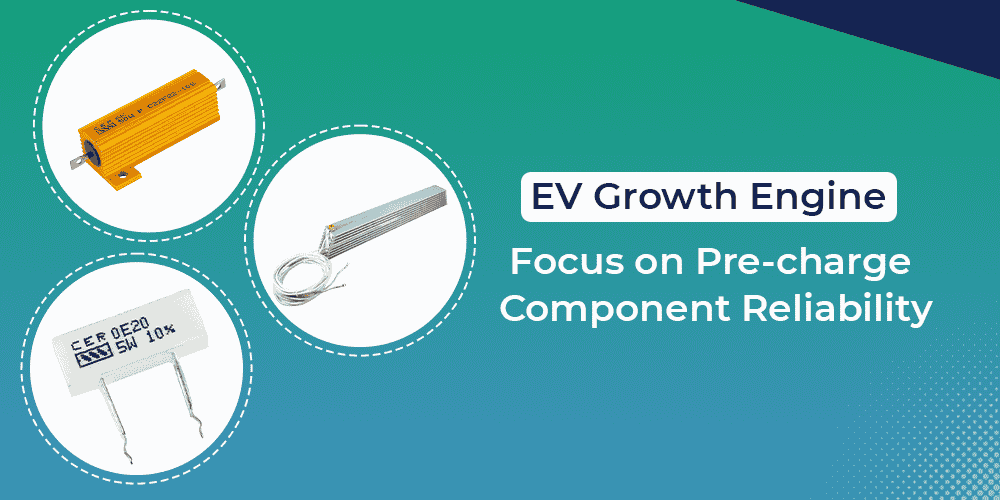
EV Growth Engine: Focus on Pre-charge Component Reliability
We are all seeing it on the roads every day. The electric vehicle (EV) revolution is here, and it is rapidly changing India’s mobility landscape. From sleek new cars to electric buses and scooters, the shift is undeniable. For us in the manufacturing and engineering world, this boom is more than just a trend; it is a massive new industrial engine.
But the real story is not just about the vehicles. It is about the incredibly complex, high-tech systems working silently under the hood. While many talk about motors and batteries, the real growth engine for component experts lies in specific, critical functions. Forget simple auto electronics; the conversation today must be about the EV Pre-charge circuit and the absolute need for its reliability.
What is an EV Pre-charge Circuit, Anyway?
Let’s break this down in simple terms. An electric vehicle’s powertrain runs on a very high-voltage battery. This battery is connected to a part of the system called the capacitor bank, which helps smooth out the power delivery.
Now, imagine you have a giant water tank (the battery) connected to a pipe. If you suddenly open the main valve (the main switch, or contactor) all at once, you get a massive, damaging rush of water that could burst the pipes.
The same thing happens in an EV. If the high-voltage battery were connected directly to the system, there would be a huge “inrush current.” This surge of electricity would be so powerful it could weld the main contactors shut, severely damage them, or harm other sensitive electronics.
The EV Pre-charge circuit is the smart, protective solution to this problem.
It works like a smaller bypass pipe. Before the main “valve” opens, the EV Pre-charge circuit uses a special, high-power resistor to slowly and gently fill up the capacitors. It “pre-charges” them to about 95% of the battery voltage. Once the system is safely pressurised, the main contactors can close without any dangerous surge. This entire, critical process happens in a second, every single time you start the car.
Why This is a High-Stakes Application
This simple-sounding function is, in reality, a high-stakes application of EV Pre-charge. The reliability of this one circuit can be the difference between a smooth-running vehicle and a complete system failure.
What happens if the EV Pre-charge system fails?
- If the pre-charge resistor fails open: The capacitors will not charge. The vehicle’s brain will still command the main contactors to close, but they will be closing onto an empty circuit. This will cause the very inrush current it was designed to prevent, leading to welded contactors and a critical failure. The car will not start.
- If the system fails to engage: The vehicle is stranded. It is not like a minor glitch with the radio; this is a fundamental failure that stops the entire powertrain.
This is why we call it a high-stakes application of EV Pre-charge. There is no room for error. Failure here means expensive repairs, warranty claims, damage to the brand’s reputation, and a loss of customer trust. For a system so central to the vehicle’s operation, reliability is not just a feature; it is the entire foundation. This makes every component in the EV Pre-charge system absolutely critical.
The Unsung Hero: The Pre-charge Resistor
The heart of the entire EV Pre-charge circuit is the pre-charge resistor. This component has a very tough job. For a brief moment, it must stand alone against the battery’s full voltage and absorb a significant pulse of energy. Then, it gets bypassed. It must do this perfectly, thousands and thousands of times over the life of the vehicle, without changing its properties.
This is not a job for a standard, off-the-shelf resistor. The component chosen for the EV Pre-charge application must be specifically designed to handle high voltage peaks and absorb large amounts of pulse energy reliably. The design of the EV Pre-charge system depends entirely on the resistor’s ability to perform.
This specific, demanding role is precisely what makes the EV Pre-charge sector such a massive opportunity. The demand is not just for any resistor, but for a high-reliability, high-performance power resistor.
The Growth Engine Beyond the Car
This critical need for EV Pre-charge technology is not limited to the cars themselves. The entire ecosystem is built on this principle.
- EV Charging Infrastructure: A DC fast charger is essentially a massive power conversion system. It also uses large capacitor banks and requires a robust EV Pre-charge circuit to operate safely.
- Battery Management Systems (BMS): Any large battery pack, whether for a vehicle or for grid storage, needs a reliable EV Pre-charge system to connect safely.
This is why we see the EV Pre-charge segment as a core growth engine. As India’s EV infrastructure grows, the demand for these reliable, high-stakes components will only multiply. This is the high-stakes application of EV Pre-charge that will define the next decade of power electronics.
Your Partner in EV Pre-charge Reliability
As a leading Indian manufacturer with decades of expertise in resistor technology, we at Cermet Resistronics understand this challenge deeply. We see the EV Pre-charge system not as a new trend, but as a classic power electronics problem that demands a robust solution.
We do not just sell Power Resistors; we provide engineered solutions. We work with designers to understand the specific pulse energy and voltage of their EV Pre-charge system. Our power resistors are designed and tested to meet the demanding reliability required by this high-stakes application of EV Pre-charge.
When you are building a system where failure is not an option, you need more than a component supplier. You need an engineering partner. At Cermet Resistronics, we are ready to be that partner, helping to build a reliable and powerful EV future for India, one EV Pre-charge circuit at a time.

